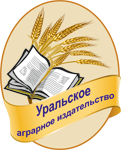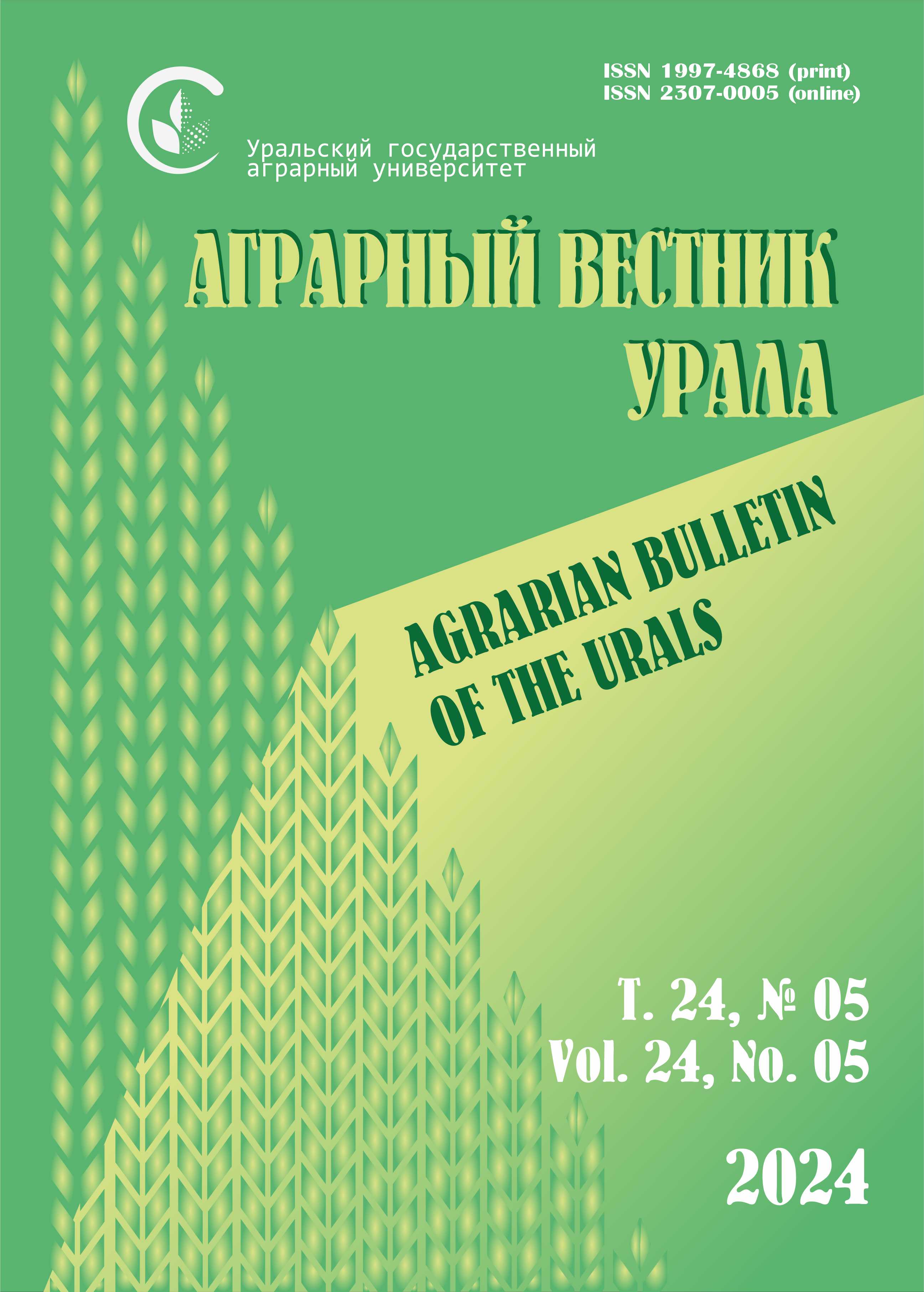Russian Federation
The purpose of the study is to analyze the effectiveness of the use of the obtained fertilizers on the sowing characteristics of agricultural seeds. The article presents the results of a study on the effectiveness of the use of organic fertilizers on crops of cumin, carrots and corn. To obtain organic fertilizers based on vermicompost (V) and chicken droppings (CD) in different, cavitation treatment technology was used. To identify competitiveness, the effectiveness of the influence of the obtained organic fertilizers based on vermicompost and chicken manure was compared with certified fertilizers “Sila Rosta” and “Riverm”. Results and practical significance. According to the results of the experiment, the following patterns were revealed: for carrot seeds, based on germination energy and germination, the best indicators were achieved when treated with a fertilizer based on vermicompost; for cumin seeds, based on germination energy, the best indicators were achieved when treated with a fertilizer based on chicken droppings, and organic fertilizers of the “Sila Rosta” and vermicompost brands gave priority to germination results. The results were also obtained on the basis of an increase in the biomass of aboveground organs and an increase in root length, patterns were revealed for the proposed concentrations of chicken droppings. Scientific novelty. The resulting organic fertilizer based on chicken droppings increases the germination energy and germination for carrots and cumin, and also provides the greatest increase in the biomass of sprouts for cumin and corn, and roots for carrots and corn. Fertilizer from vermicompost is characterized by the highest efficiency in assessing the sowing qualities of carrots.
vermicompost, germination energy, germination, Daucus carota L., Carum carvi L., Zea mays L., growth of the sprout length, the increase in the length of the root
1. Nevzorov M. A., Nevzorov A. I. Mineral'nye i organicheskie udobreniya kak faktor povysheniya plodorodiya pochv pri vyraschivanii kukuruzy na silos // Nauka i obrazovanie. 2020. T. 3, № 3. S. 308–316.
2. Kapustin V. P., Rodionov Yu. V., Skomorohova A. I. Povyshenie kachestva organicheskih udobreniy – osnova urozhaev sel'skohozyaystvennyh kul'tur // Nauka v central'noy Rossii. 2021. T. 4, № 52. S. 17–25. DOI:https://doi.org/10.35887/2305-2538-2021-4-17-25. EDN: https://elibrary.ru/YJVDNP
3. Chernov S. A., Matveev V. V. Organicheskie udobreniya kak faktor neytralizacii ugrozy prodovol'stvennoy inflyacii // Zdorov'e – osnova chelovecheskogo potenciala: problemy i puti ih resheniya. 2021. T. 16, № 4. S. 1748–1752. EDN: https://elibrary.ru/IZWAYS
4. Vokkosov Z. K., Kanoatov H. M., Mehmanov B. I.., Ortigalieva U. R. Razrabotka i issledovanie effektivnosti organicheskih udobreniy // Universum: tehnicheskie nauki: elektronnyy nauchnyy zhurnal. 2022. T. 12, № 105. S. 14768–14774. DOI:https://doi.org/10.32743/UniTech.2022.105.12.14768. EDN: https://elibrary.ru/IFUXXQ
5. Konovalova L. K. Ekonomicheskaya effektivnost' primeneniya organicheskih udobreniy v razlichnyh usloviyah proizvodstva // Agrarnyy vestnik Verhnevolzh'ya. 2020. № 1. S. 120–124. DOI:https://doi.org/10.35523/2307-5872-2020-30-1-120-124. EDN: https://elibrary.ru/HRZPIF
6. Zav'yalova N. E., Shishkov D. G., Ivanova O. V. Vliyanie vozrastayuschih doz mineral'nyh udobreniy na urozhaynost' i pokazateli kachestva klubney kartofelya // Agrarnaya nauka Evro-Severo-Vostoka. 2023. T. 24, № 3. S. 409–416. DOI:https://doi.org/10.30766/2072-9081.2023.24.3.409-416. EDN: https://elibrary.ru/QFTSPA
7. Barkovskaya T. A., Gladysheva O. V., Kokoreva V. G. Ocenka adaptivnosti i potencial'noy produktivnosti yarovoy myagkoy pshenicy v usloviyah Ryazanskoy oblasti // Agrarnaya nauka Evro-Severo-Vostoka. 2023. T. 24, № 1. S. 58–65. DOI:https://doi.org/10.30766/2072-9081.2023.24.1.58-65. EDN: https://elibrary.ru/FTMXHZ
8. Prokina L. N., Pugaev S. V. Ispol'zovanie makro- i mikroudobreniy v posevah yachmenya v polevom sevooborote na chernozeme vyschelochennom // Agrarnaya nauka Evro-Severo-Vostoka. 2023. T. 24, № 3. S. 440–447. DOI:https://doi.org/10.30766/2072-9081.2023.24.3.440-447. EDN: https://elibrary.ru/IFPXDQ
9. Sheudzhen A. H., Gutorova O. A., Bondareva T. N. [i dr.] Vliyanie mineral'nyh i organicheskih udobreniy na rost i razvitie rasteniy risa // Risovodstvo. 2022. T. 2, № 55. S. 57–62. DOI:https://doi.org/10.33775/1684-2464-2022-55-2-57-62. EDN: https://elibrary.ru/GTFXLB
10. Mironenko O. V. Organicheskiy rynok Rossii: sostoyanie i perspektivy. Nacional'nyy organicheskiy soyuz // Pererabotka moloka. 2017 T. 7, № 213. S. 48–53. EDN: https://elibrary.ru/YZJOCP
11. Naprienko A. A. Kavitaciya [Elektronnyy resurs] // Molodezh' i nauka: sbornik materialov IH Vserossiyskoy nauchno-tehnicheskoy konferencii studentov, aspirantov i molodyh uchenyh s mezhdunarodnym uchastiem, posvyaschennoy 385-letiyu so dnya osnovaniya g. Krasnoyarska. Krasnoyarsk, 2013. S. 16–20. URL: https://elib.sfu-kras.ru/handle/2311/10929?ysclid=lnhe3smzbq16317043 (data obrascheniya: 10.01.2024).
12. Koval'chuk A. N., Lefler T. F., Stroganova I. Ya. [i dr.] Tehnologiya obezzarazhivaniya svinogo navoza // Vestnik KrasGAU. 2017. № 11. S. 71–79. EDN: https://elibrary.ru/ZXFKSX
13. Rukovodstvo pol'zovatelya. Gidrodinamicheskaya mel'nica-kavitator «Aktivator-Gd» [Elektronnyy resurs]. 2022. URL: http://www.activator.ru/AcGd.html (data obrascheniya: 10.01.2024).
14. Rukovodstvo pol'zovatelya. SPEKTROSKAN MAKS-GVM [Elektronnyy resurs]. 2022. URL: https://spectronxray.ru/devices/spektrometers/spectroscan-maks-gv (data obrascheniya: 10.01.2024).
15. Zupanc M., Pandur Ž., Stepišnik Perdih T., Stopar D., Petkovšek M., Dular M. Effects of cavitation on different microorganisms: The current understanding of the mechanisms taking place behind the phenomenon. A review and proposals for further research // Ultrasonics Sonochemistry. 2019. Vol. 57. Pp. 147–165. DOI:https://doi.org/10.1016/j.ultsonch.2019.05.009. EDN: https://elibrary.ru/TCRKRJ
16. Pat. 2 735 961 Ros. Federaciya: MPK C05F 3/00/B82B3/00/B82Y40/00/ Kavitacionnyy sposob obezzarazhivaniya zhidkih organicheskih othodov i prigotovleniya organomineral'nyh udobreniy [Elektronnyy resurs] / Kostenko M. Yu. [i dr.]; zayavitel' i patentoobladatel' FGBOU VO «Ryazanskiy gosudarstvennyy agrotehnologicheskiy universitet imeni P. A. Kostycheva». N 2019138106; zayavl. 25.11.2019 ; opubl. 11.11.2020, Byul. N32. URL: https://patenton.ru/patent/RU2735961C1.pdf (data obrascheniya: 10.01.2024).
17. Komarova E. V., Slabunova A. V., Kharitonov S. E. Applying the cavitation effect in animal wastewater treatment [Elektronnyy resurs] // Ecology and water management. 2021. Vol. 3, No. 2. Pp. 61–74. URL: https://www.researchgate.net/publication/352482439_APPLYING_THE_CAVITATION_EFFECT_DURING_ANIMAL_WASTEWATER_TREATMENT (data obrascheniya: 10.01.2024). DOI: https://doi.org/10.31774/2658-7890-2021-3-2-61-74; EDN: https://elibrary.ru/SVKRFF
18. GOST 12038-84. Semena sel'skohozyaystvennyh kul'tur. Metody opredeleniya vshozhesti. Moskva: Standartinform, 2020. 40 s.
19. GOST 12036-85. Semena sel'skohozyaystvennyh kul'tur. Pravila priemki i metody otbora prob. Moskva: Standartinform, 2020. 14 s.
20. Kallas E. V., Novikova A. S., Valevich T. O. Opredelenie kolichestvennyh i kachestvennyh harakteristik gumusa razlichnymi metodami i interpretaciya poluchennyh rezul'tatov: metodicheskie ukazaniya. Tomsk: Tomskiy gosudarstvennyy universitet, 2020. 55 s.
21. GOST 26713-85. Udobreniya organicheskie. Metod opredeleniya vlagi i suhogo ostatka [Elektronnyy resurs]. Moskva: Gosstandart, 1985. 6 s.
22. GOST 26712-94. Udobreniya organicheskie. Obschie trebovaniya k metodam analiza. Minsk: Mezhgosudarstvennyy sovet po standartizacii, metrologii i sertifikacii, 1994. 12 s.
23. GOST 27980-88. Udobreniya organicheskie. Metody opredeleniya organicheskogo veschestva. Moskva: Gosstandart, 1988. 11 s.
24. GOST 31461-2012. Pomet pticy. Syr'e dlya proizvodstva organicheskih udobreniy [Elektronnyy resurs]. Moskva: Standartinform, 2020. S. 6.
25. GOST R 56004-2014. Udobreniya organicheskie. Vermikomposty. Tehnicheskie usloviya. Moskva: Standartinform, 2020. 12 s.
26. GOST R ISO 21748-2021. Nacional'nyy standart Rossiyskoy Federacii. Statisticheskie metody. Rukovodstvo po ispol'zovaniyu ocenok povtoryaemosti, vosproizvodimosti i pravil'nosti pri ocenke neopredelennosti izmereniy. Moskva: Rossiyskiy institut standartizacii, 2021. 36 s.
27. Kosenko S. V., Pluzhnikova I. I. Vliyanie bioudobreniya «AGROVERM» na process prorastaniya semyan zernovyh kul'tur // Vestnik Altayskogo gosudarstvennogo agrarnogo universiteta. 2020. № 10 (192). S. 19–23. EDN: https://elibrary.ru/VILBVM









